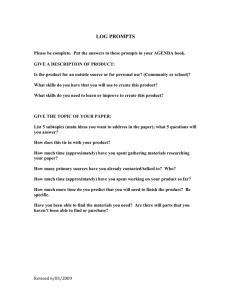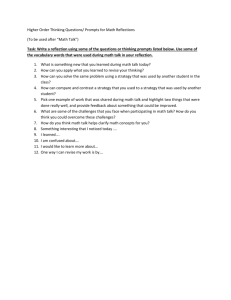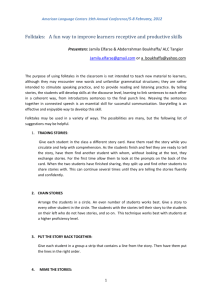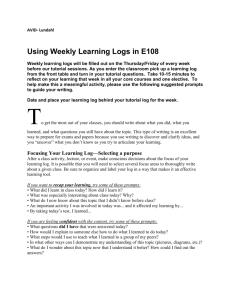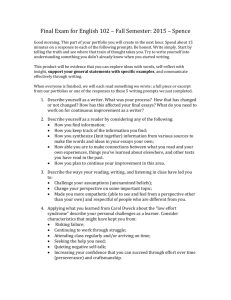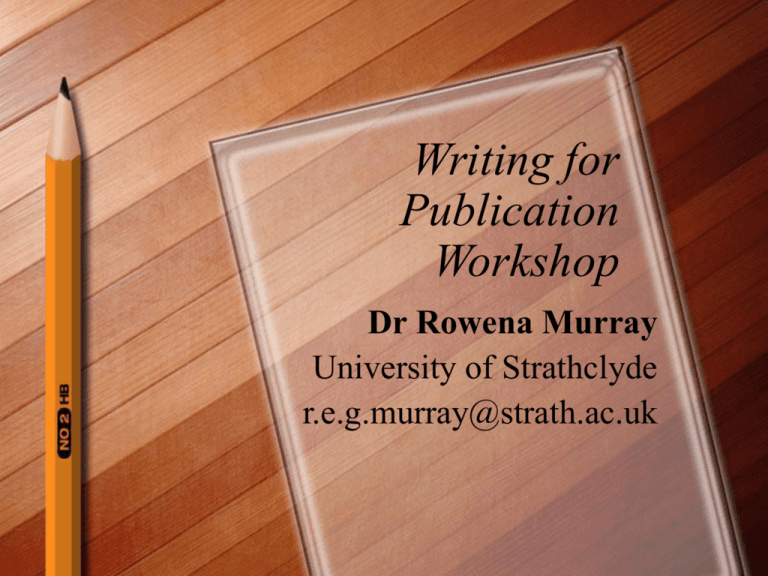
Writing for
Publication
Workshop
Dr Rowena Murray
University of Strathclyde
r.e.g.murray@strath.ac.uk
Two types of approaches to writing
1. Targeting journals, analysing journals,
dialogue with editors and published
writers, ‘callibrating’ your writing,
dealing with reviewers’ feedback
2. Writing to prompts, freewriting,
generative writing
Writing for publication: principles
Using tried & tested strategies
Discussion: rehearsing arguments
‘Pre-peer review’ on writing-in-progress
Writing/revising time -- increasing
Analysing published writing
Developing paper/chapter @ meetings
‘Binge’ and ‘snack’ writing
Workshop format
Presentations: principles and rationales
Writing activities
Peer & group discussion, plenary
Peer review
Analysing published writing
Writing time: options …
Goal-setting for writing
Writing to prompts
What writing [for publication] have
you done, and what would you like to
do [in the long, medium and short term]?
5 minutes’ writing
In sentences
Private writing -- no one will read it
To be discussed in pairs/groups
Prompts to make a paper’s
‘contribution’ explicit
• This research shows/reveals/confirms …
• This is a contribution in the sense that …
• This is a contribution to the extent that …
Prompts for internalising the debate
•
•
•
•
•
Some will argue that …
One interpretation could be …
However, this could be taken as …
This is not to say that …
Possible interpretations include …
Prompts from journals: openers
‘During the last two decades the higher
education system in the UK has moved
from an élite to a mass orientation, while
academic careers have become less
secure and more demanding, and a
greater accountability has been imposed
upon the system.’
(Blaxter et al, 1998)
Prompts from journals:
contributions
‘The future development of these, and
other, areas of writing on academic
careers, is considered’(Blaxter et al,
1998).
‘… suggests an alternative to traditional …
programs …’ (Boice, 1987).
‘These findings suggest that short writing
courses can be of benefit … but that
such courses should focus directly on …
(Torrance et al, 1993).
Active verbs for discussing ideas
Informs, reviews, argues, states,
synthesises, claims, answers, explains,
reconsiders, provides, maintains,
outlines, supports, compares, lists,
acknowledges, confirms, analyses,
disputes, concludes, reveals, implies,
reminds, suggests, considers, highlights,
refutes, assembles, shows, adds,
clarifies, identifies (Ballenger, 2009)
Prompts for generating text
Warm up prompts, e.g. 5 minutes taking stock and
goal-setting.
Generic prompts, e.g. ‘The purpose of this paper is to
… This suggests that …’
Journal prompts, e.g. …?
Questions, e.g. ‘What do I want to write?’
In outlines, i.e. as well as headings.
Revision prompts, e.g. ‘Define other approaches’.
Notes on prompts
Use both formal and informal
Try question and fragment forms
Use 1st person (i.e. ‘I’ and ‘we’)
Use verbs -- they make purposes explicit
Use prompts for taking stock & setting new
goals
As a warm up for writing
To engage with/solve writing problems
To build your confidence
To vent emotions and/or analyse problems
Preparing to write
Decide on specific writing project
Choose target journal
Email journal editor about your
paper’s topic, contribution and
appropriateness of your paper for that
journal
Collect information about journal
Select sample paper from the journal
Freewriting
Write for 5 minutes
In sentences
Without stopping
Private writing -- no one will read it
Write about about the subject of your paper
and/or about your target journal
Brainstorm in sentences
Structure and coherence not required
Explore many angles, do ‘open’ writing
Generative writing
Same routine as freewriting
But more focused, more ‘closed’
Write about the verbs for your paper
and/or for sections of your paper
Or use your freewriting as your focus
To be read by one other person in the
group
Free- and generative writing
in writing for publication
To get started
To explore possibilities
To silence the ‘internal editor’ temporarily
To develop confidence
To develop fluency
To work out a complex argument
To do rough drafting
Pros & cons
‘Freewheelers’ like it; ‘structurers’ don’t.
It’s probably good to use both types of
writing strategy.
You need to try it for a while to see
whether it has benefit for your writing
process.
It may be important to ‘write about your
writing’ for some of the time.
References
Freewriting
Elbow, P. (1973) Writing without teachers.
Oxford: Oxford University Press.
Generative writing
Boice, R. (1990) Professors as writers: A
self-help guide to productive writing.
Stillwater, OK: New Forums Press.
Brown’s 8 questions
To draft an abstract
Not just for experimental work
Set word limits
Using generic structure
Generating text you can work on later
Write abstract first, revise it as you go
Construct/see the whole argument
Brown’s 8 questions
1.
2.
3.
4.
5.
6.
7.
8.
Who are intended readers? (3-5 names)
What did you do? (50 words)
Why did you do it? (50 words)
What happened? (50 words)
What do results mean in theory? (50 words)
What do results mean in practice? (50
words)
What is the key benefit for readers (25
words)
What remains unresolved? (no word limit)
Outlining
3 levels of outlining
Aligning your outline with your abstract
Aligning your outline with target journal
Peer feedback
Writing your outline in sentences
Goal-setting for writing
Level 1 outlining
Main headings = ‘broad brushstroke’
Easy to align with type of heading used
in target journal
Checks coherence of your argument
Imposes word limit appropriate for your
work and the target journal
Using key words of your topic
Level 2 outlining
Sub-headings -- as prompts
As in your target journal
Break your main heading into parts
This helps you decide on content
May help if you write in sentences: e.g.
The purpose of this section is to …
Set word limits for sections and subsections.
Level 3 outlining
Makes you really decide on content
Lets you check if it’s all needed
Check your sub-sub-headings ‘add up to’
your headings and draft abstract
Set word limits
Write about content in sentences
Revise as you go along
Signposting
Make explicit connections in advance
‘Forecast’ structure of your paper
Say how sections link
Define and justify proportions of your paper
Link to your defined research question/gap
Give readers a route through your paper
Establish key terms for your paper
Signalling
Make links explicit, as you go along
Use link words at the start of section,
paragraphs and sentences
Refer forwards and back in your paper
Make the development of your argument from
section to section explicit
Say what you are doing at each stage
Repeat your key terms
A combined strategy
Use both structuring and ‘freewheeling’.
Recognise your preference and use
different strategies for different
purposes.
Use a detailed outline to plan increments
for your writing.
Defining writing tasks first -- may
make it easier to find time for them.
Common reasons why papers are rejected
•
•
•
•
•
Study did not examine important issue.
Study not original; similar one already done.
Study did not test author’s hypothesis.
Different type of study should have been done.
Practical difficulties led authors to
compromise on original design.
Greenhaulgh (2006)
Common reasons why papers are rejected
• Sample size too small.
• Study was uncontrolled or inadequately
controlled.
• Statistical analysis incorrect or inappropriate.
• Unjustified conclusions drawn from data.
• Conflict of interest, e.g. financial gain from
publication, lack of safeguard against bias.
• So badly written it is incomprehensible.
Greenhaulgh (2006)
What do reviewers say?
Comment on your methodology
Critique of your conceptual framework
Challenging link between research aims
& methods or data & conclusions
Gaps in your lit review/references
Disagreeing with your use of terms
Questioning assertion of contribution
Reviewer 1
My impression of the paper by Dr R Murray
entitled … is very negative. A short, 2-printedpage statement would be useful as an
invitation for discussion. The authors make
many superficial statements, often clearly not
based on any direct experience of curricular
developments. I am convinced that our journal
would not benefit from such a lengthy
manuscript whose content is very limited.
Reviewer 2
Cet article aborde la question de l’interactivité
dans l’enseignement. C’est un problème
important et l’exposé est très intéressant.
Même si on n’y trouve pas d’éléments
nouveaux ni de recette miracle, il me semble
que le problème est bien posé et les
considerations énumerées me semblent
constituer un bon point de la situation. Ainsi
par exemple, je trouve que pour organiser un
débat sur la question, la lecture préalable de ce
texte constituerait un excéllent point …
Reviewer 2 continues …
… Moyennant ces quelques remarques, je
crois que, par sa bonne synthèse d’une
importante problematique, cet article
mériterait une publication dans l’EJEE.
The Editor decides
Two experts of the Editorial Board of the EJEE
examined your paper … One of them is very
opposed to the publication of your paper in its
present form. Another one considers your
paper interesting but claims for a re-writing of
the document. You will see, attached, their
comments…. Here are the most important
points to take into account:
The Editor lists the
‘most important points’
• try to introduce the problem of interactivity within the title of the
paper;
• avoid superficial statements not consolidated by some results of
concrete experiences;
• try to reduce the length of the paper, limiting your text to the
main points to be discussed;
• please avoid, in the form of the text, the use of discussions
between people.
The authors’ response
Thank you for your feedback on our paper …
which we have found very useful (as
suggested, we will change the title). We are
revising the paper now and will resubmit later
this month, or, at the latest, early next month.
If there is a particular deadline that you would
like us to meet can you let me know now?
Thanks.
Dealing with reviewers’ feedback
If it’s not rejected, revise and resubmit ASAP.
If it is rejected, revise, target another journal and
submit ASAP.
Expect positives and negatives in reviews.
Analyse: what do they want you to do?
Ignore emotive, ‘overheated’ language.
List your revision actions: e.g. cut, add, reduce,
expand, make more explicit.
Strategies for the long term
Writer’s group: inter-disciplinary,
meeting twice a month, for 90 mins.,
with a facilitator, to progress projects
Writer’s retreat: off-campus,
residential, all work in one room/not,
non-surveillance, no email/internet, with
peer discussions of work-in-progress
Your next steps?
Define specific writing goal? Date?
Define sub-goals for achieving that. Dates?
Set date to review these goals.
Form/join a writer’s group or writer’s retreat?
Analyse articles in your target journal?
Find peer reviewers?
Identify series of writing tasks?
Submission date?
References
Ballenger, B. (2009) The Curious Researcher:
A Guide to Writing Research Papers, 6th
edition. NewYork: Pearson Longman.
Gilbert, N. (Ed.) (2006) From Postgraduate to
Social Scientist: A Guide to Key Skills.
London: Sage. See Chapter 9: ‘Writing
articles, books and presentations’.
Greenhaulgh, T. (2006) How to Read a Paper:
The Basics of Evidence Based Medicine, 3rd
edition. London: BMJ.
References
Murray, R (2009) Writing for Academic
Journals, 2nd edition. Maidenhead: Open
University Press-McGraw-Hill.
Murray, R & Moore, S (2006) The Handbook
of Academic Writing: A Fresh Approach.
Maidenhead: Open University Press-McGrawHill.
Murray, R & Newton, M (2009) Writing
retreat as structured intervention: margin or
mainstream?, Higher Education Research and
Development, 28(5): 527-539.
References
Murray, R, Thow, M, Moore, S & Murphy, M
(2008) The writing consultation: Developing
academic writing practices, Journal of Further
and Higher Education, 32(2): 119-128.

